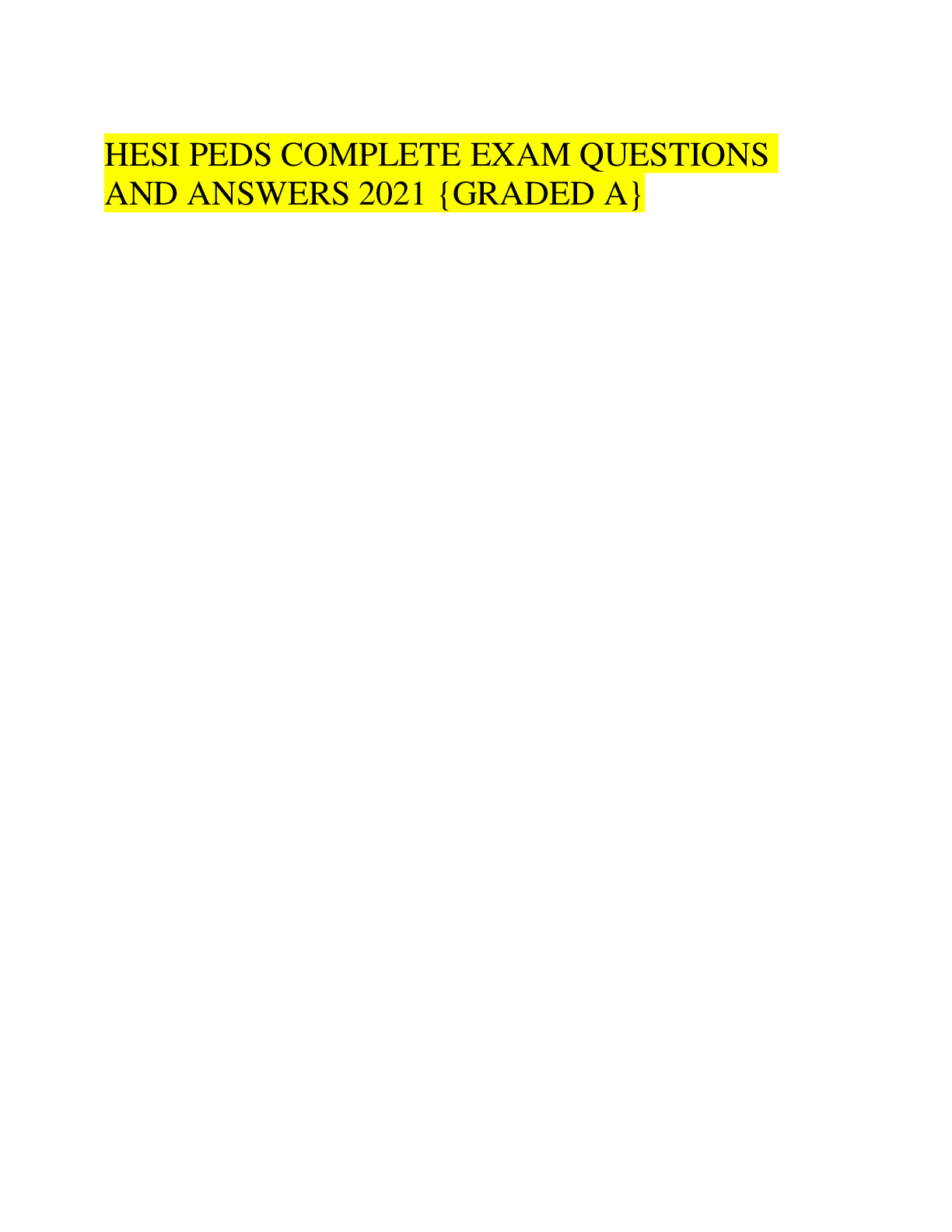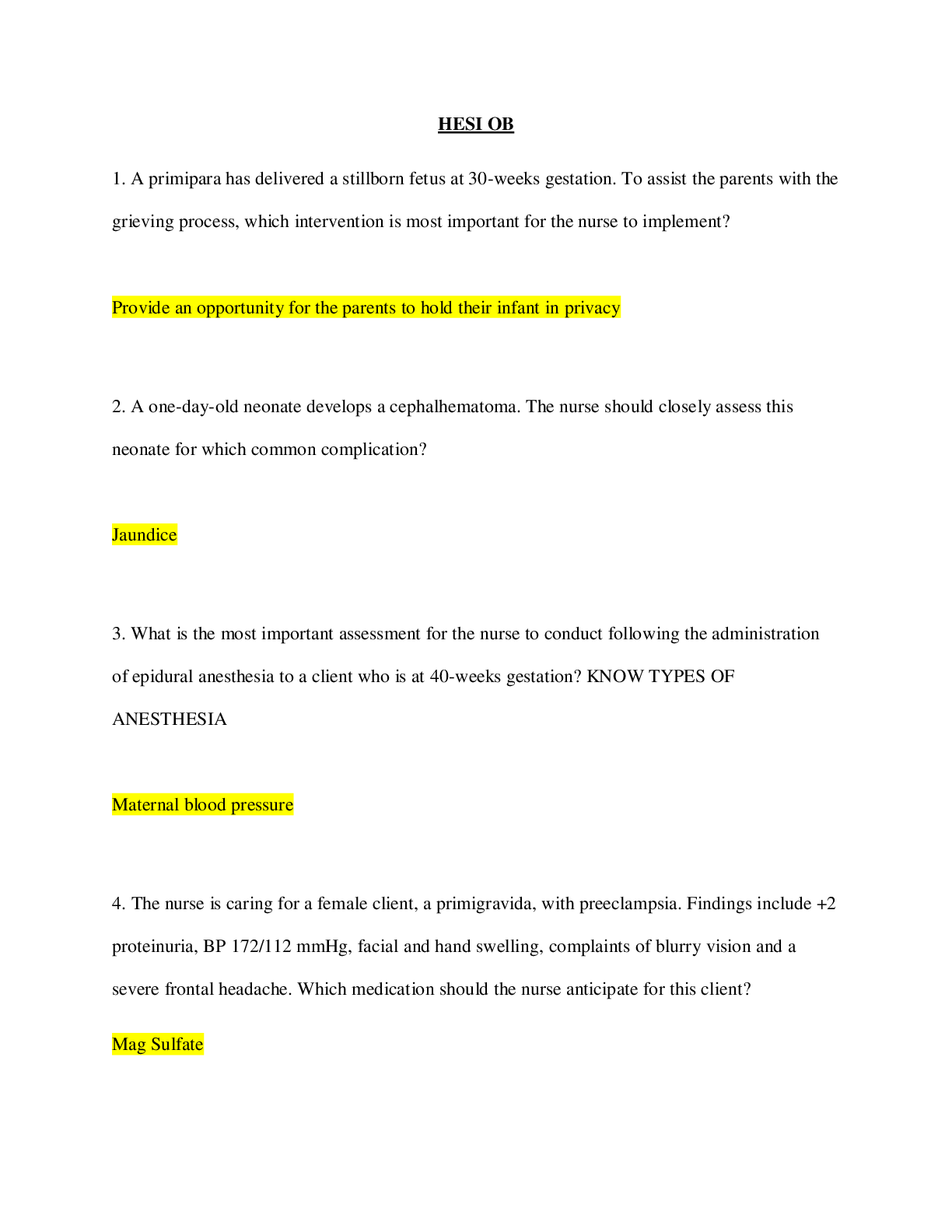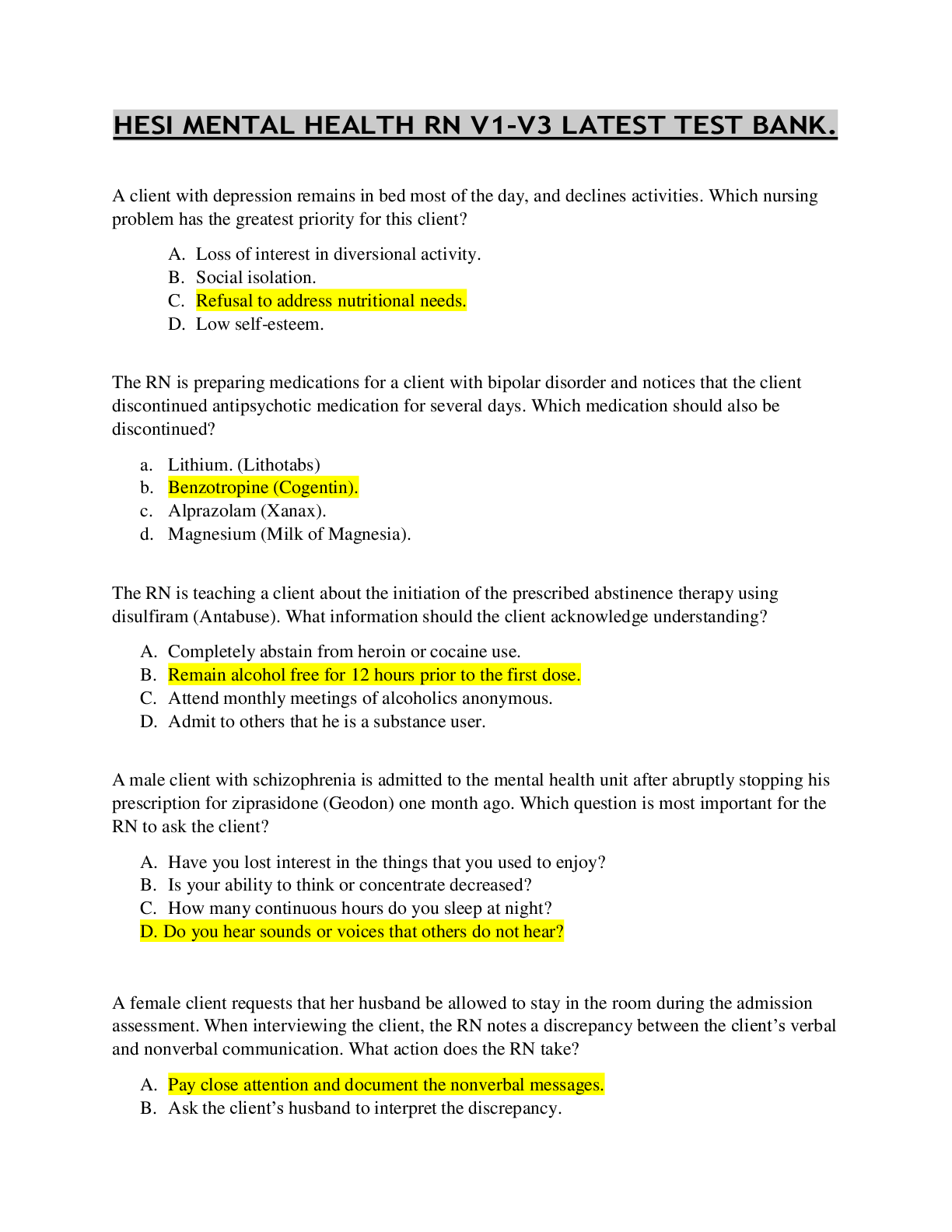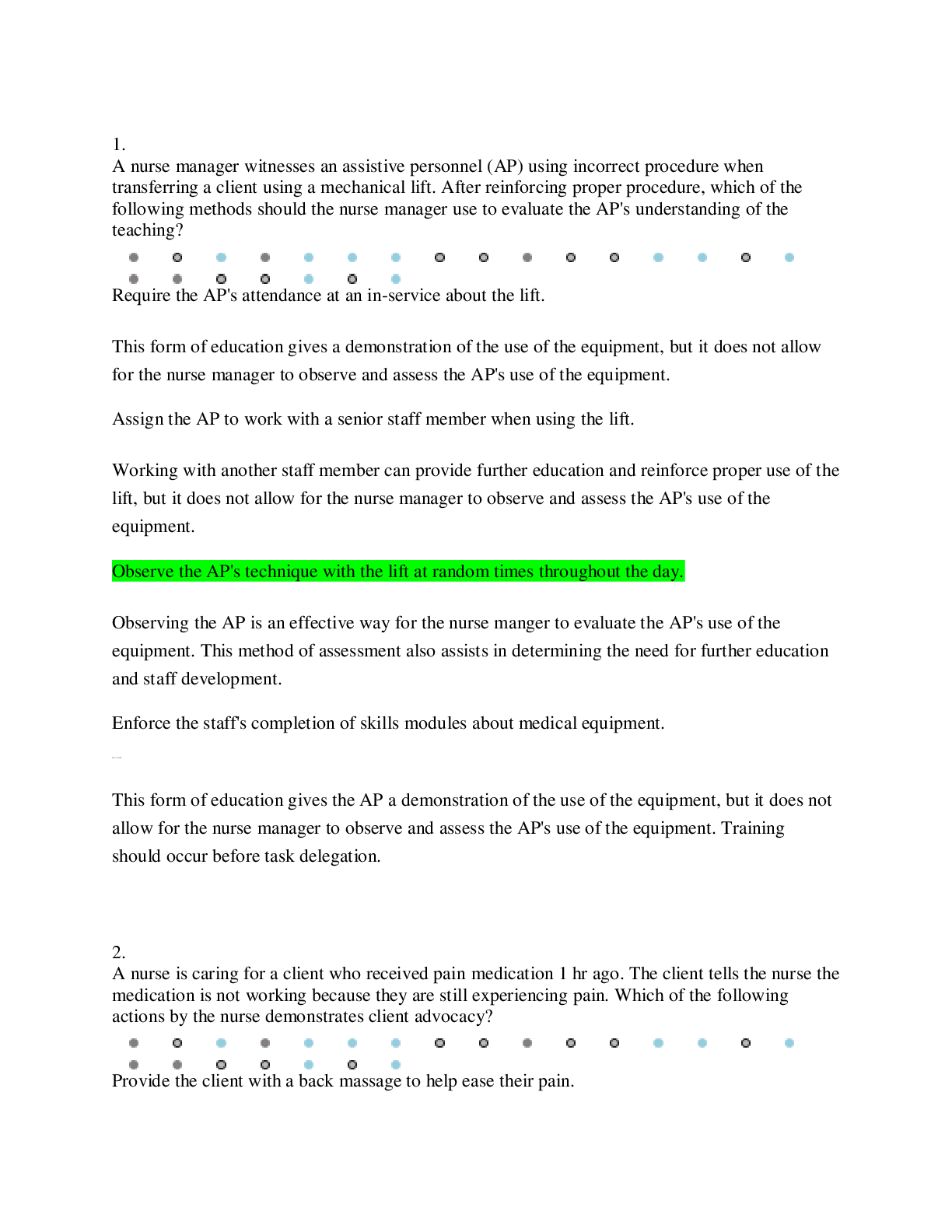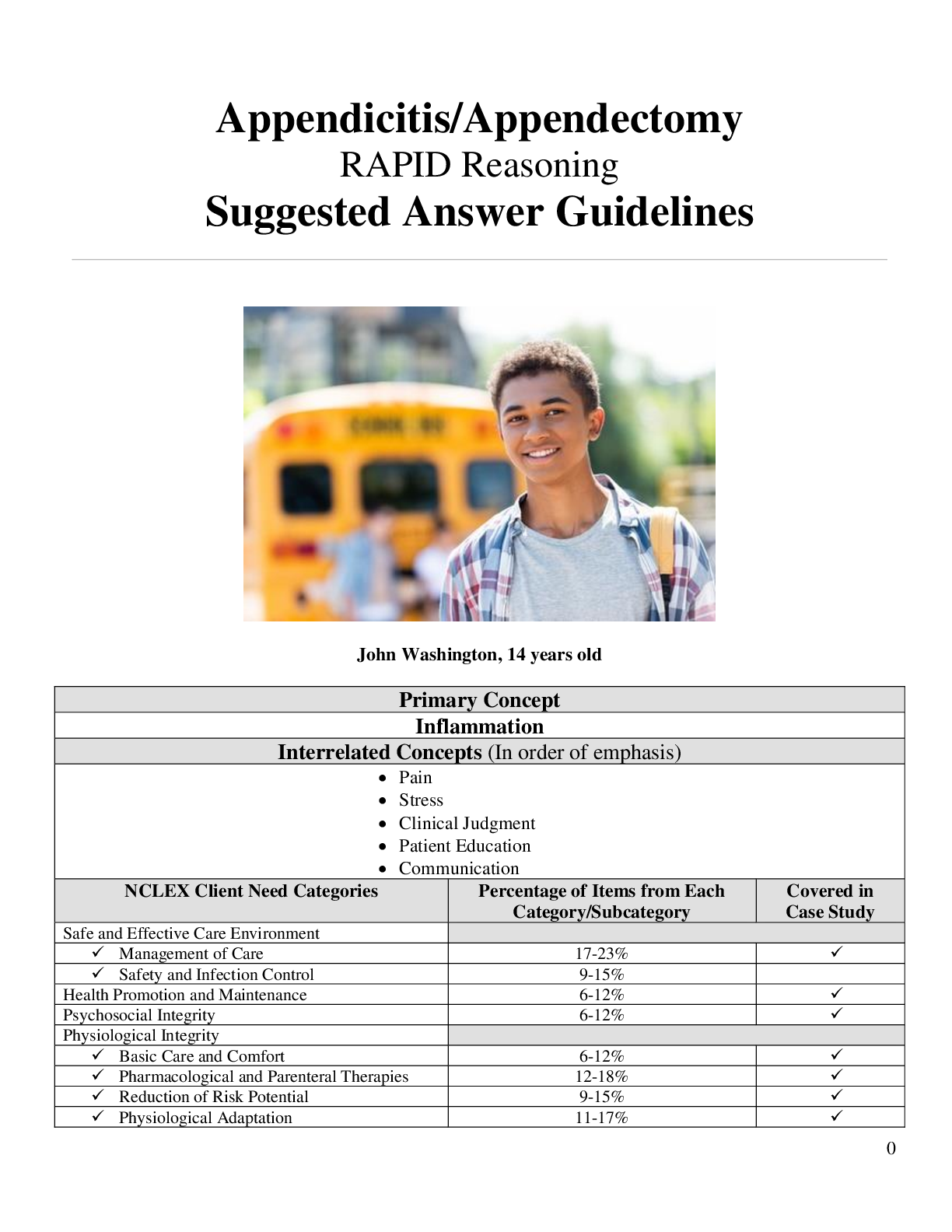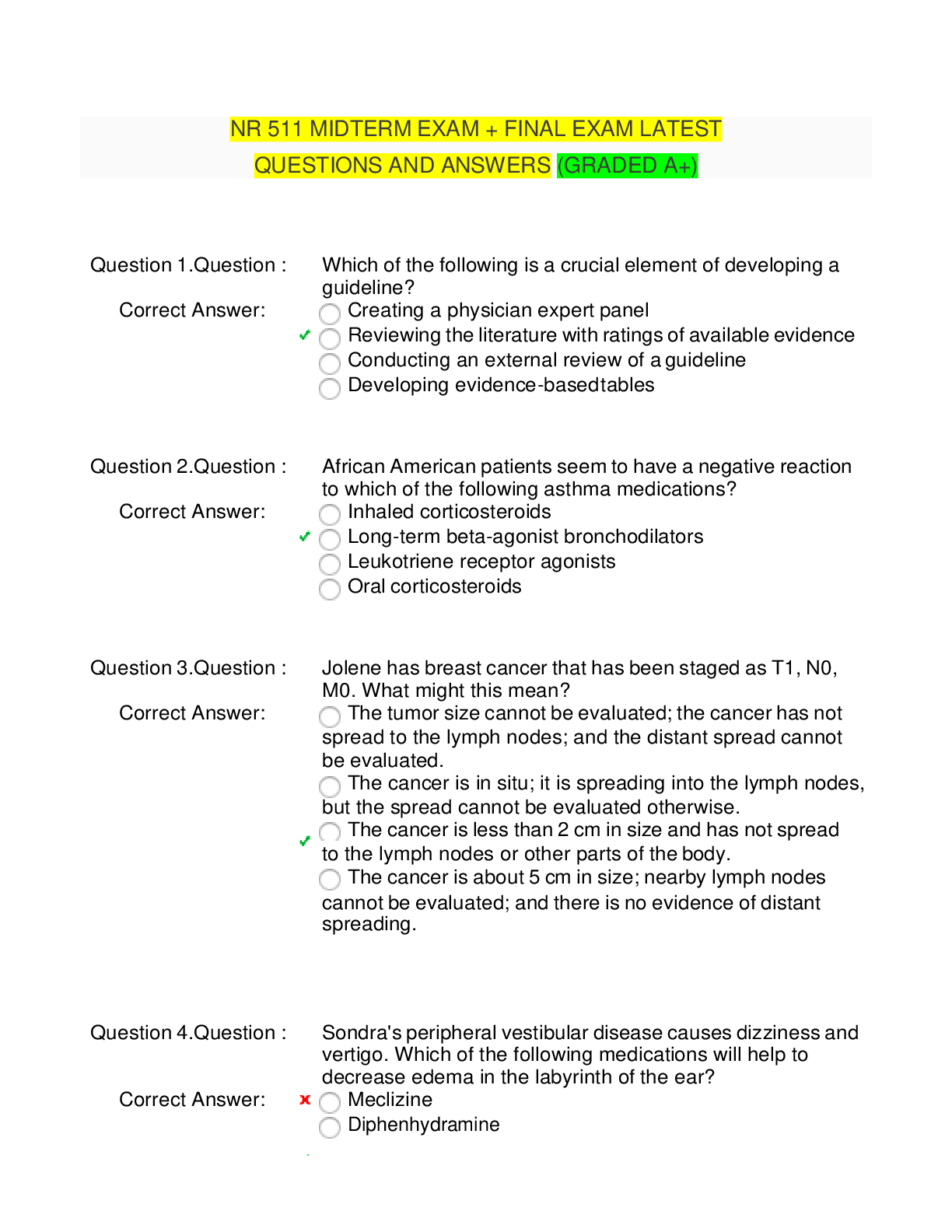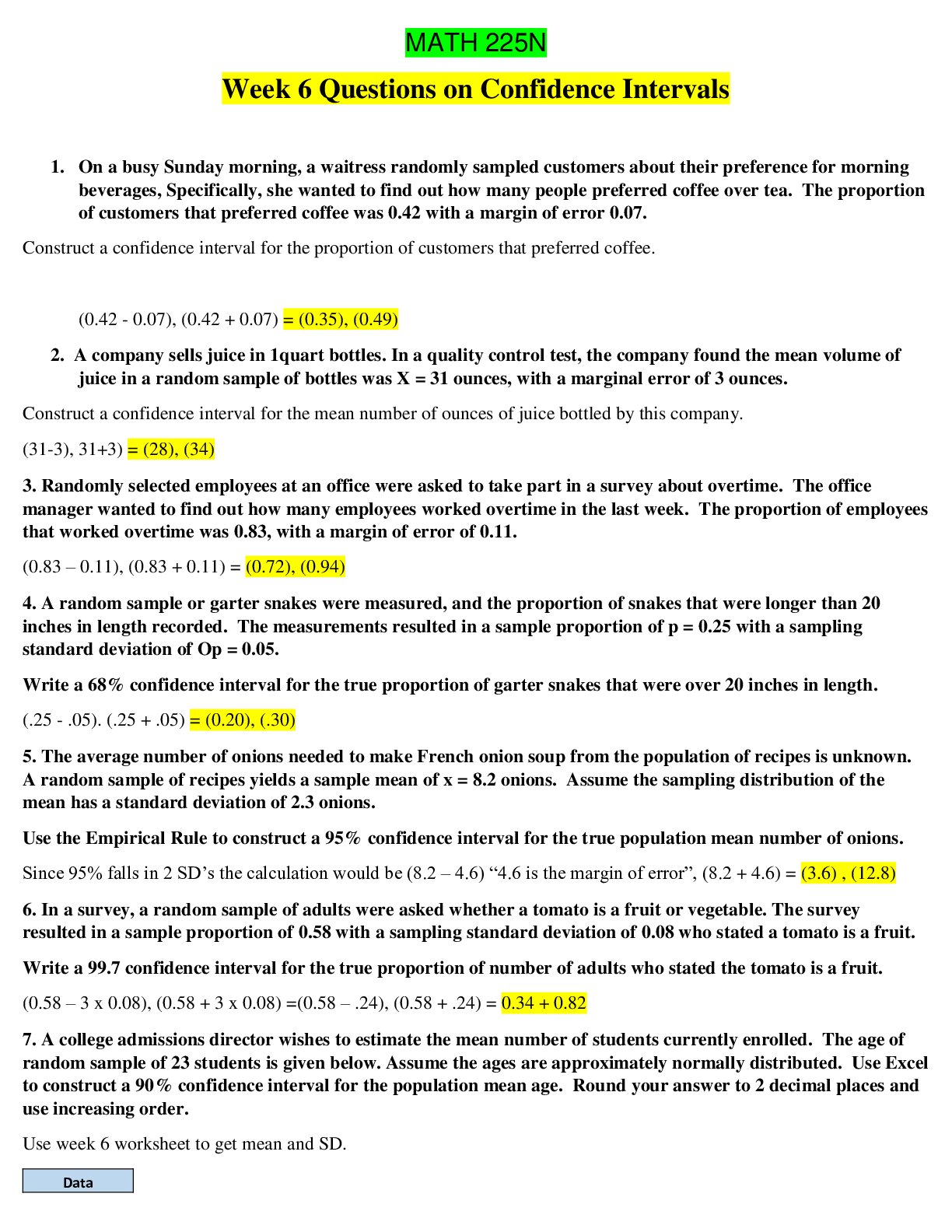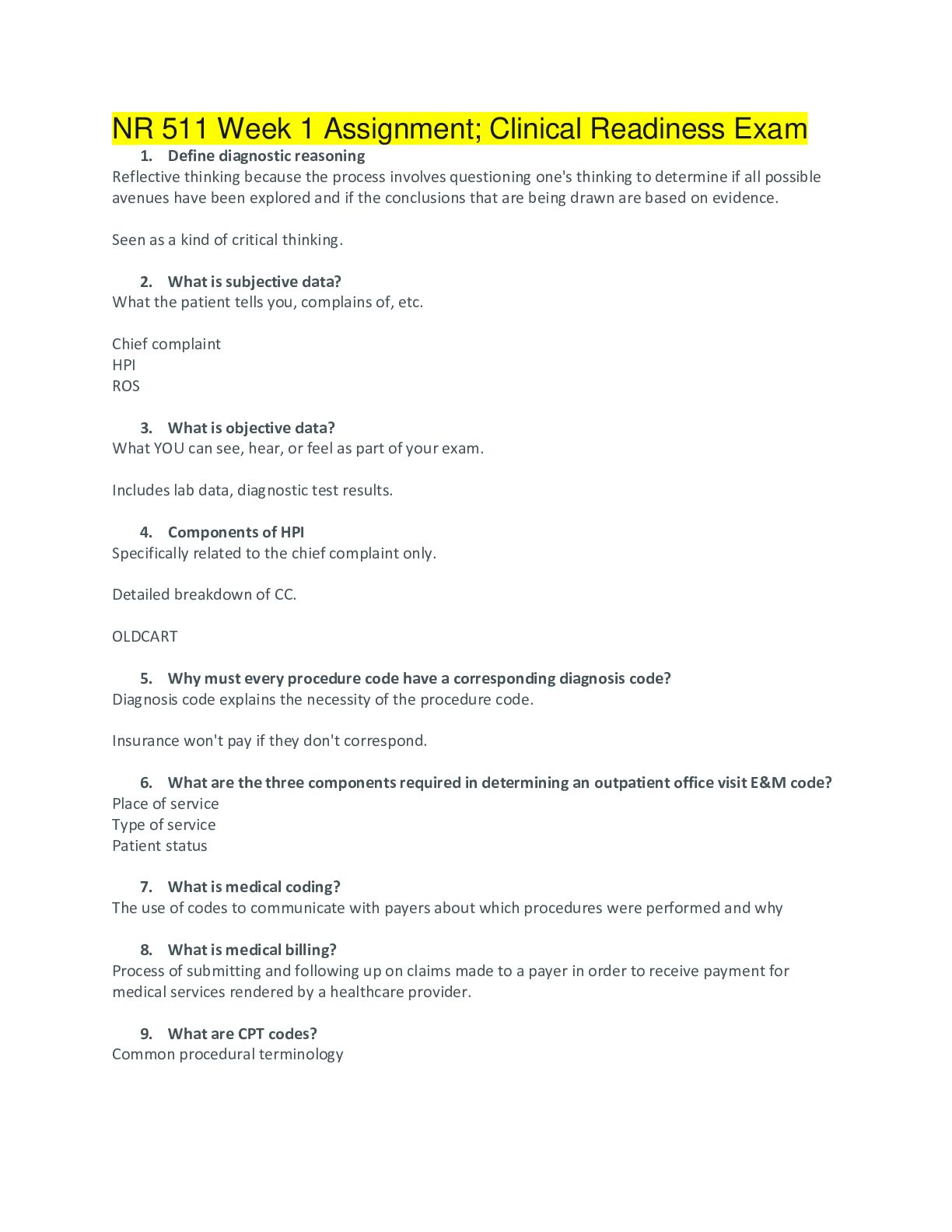*NURSING > EXAM > NURSING: POSTPARTUM Questions and Answers with Explanation: Exam Practice and Review. (62 PAGES) (All)
NURSING: POSTPARTUM Questions and Answers with Explanation: Exam Practice and Review. (62 PAGES)
Document Content and Description Below
Question 1 See full question A nurse encourages a postpartum client to discuss the childbirth experience. Which client outcome is most appropriate for this client? You Selected: • "The client demons... trates the ability to integrate the childbirth experience and progress to the task of maternal role attainment." Correct response: • "The client demonstrates the ability to integrate the childbirth experience and progress to the task of maternal role attainment." Explanation: Discussing the childbirth experience helps the client acknowledge and understand what happened during this event. The nurse should give the client a chance to ask questions about the event and seek clarification, if needed. After the client discusses the event, she may be able to shift the focus away from herself and begin the tasks that will help her assume the maternal role. The nurse must determine the client's understanding of her physical needs and those of her neonate after teaching and demonstrating care techniques; discussing the childbirth experience won't help her to meet these needs. Remediation: • Discharge Planning, Neonatal Question 2 See full question A nurse is teaching a client about hormonal contraceptive therapy. If a client misses three or more pills in a row, the nurse should instruct the client to: You Selected: • discard the pack, use an alternative contraceptive method until her period begins, and start a new pack on the regular schedule. Correct response: • discard the pack, use an alternative contraceptive method until her period begins, and start a new pack on the regular schedule. Question 3 See full question A client is 9 days postpartum and breast-feeding her neonate. The client experiences pain, redness, and swelling of her left breast and is diagnosed with mastitis. The nurse teaching the client how to care for her infected breast should include which information? • . Remediation: Question 4 See full question Which measure included in the care plan for a client in the fourth stage of labor requires revision? You Selected: • Obtain an order for catheterization to protect the bladder from trauma. Correct response: • Obtain an order for catheterization to protect the bladder from trauma. Explanation: Catheterization isn't routinely done to protect the bladder from trauma. It's done, however, for a postpartum complication of urinary retention. The other options are appropriate measures to include in the care plan during the fourth stage of labor. Remediation: Question 5 See full question A 15-year-old client gives birth to a healthy neonate. The neonate's adolescent father arrives on the unit demanding to see his baby. Both sets of grandparents are also present and asking to see their grandchild. The newly hired nurse assigned to the nursery should take which action? You Selected: • Discuss the unit's policy with the charge nurse. Correct response: • Discuss the unit's policy with the charge nurse. Explanation: Remediation: Question 6 See full question After the first breastfeeding, the client asks the nurse, “How often should I try to breastfeed?” What frequency should the nurse recommend? You Selected: • every 2 to 3 hours for the first 48 hours Correct response: • every 2 to 3 hours for the first 48 hours Explanation: Soon after giving birth, the client should breastfeed every 2 to 3 hours until her milk supply is established. Remediation: Question 7 See full question While assessing a primipara during the immediate postpartum period, the nurse plans to use both hands to assess the client's fundus to: You Selected: Question 3 See full question When instilling erythromycin ointment into the eyes of a neonate 1 hour old, the nurse would explain to the parents that the medication is used to prevent which problem? You Selected: • blindness secondary to gonorrhea Correct response: • blindness secondary to gonorrhea Explanation: The instillation of erythromycin into the neonate’s eyes provides prophylaxis for ophthalmia neonatorum, or neonatal blindness caused by gonorrhea in the mother. Erythromycin is also effective in the prevention of infection and conjunctivitis from Chlamydia trachomatis. The medication may result in redness of the neonate’s eyes, but this redness will eventually disappear. Erythromycin ointment is not effective in treating neonatal chorioretinitis from cytomegalovirus. No effective treatment is available for a mother with cytomegalovirus. Erythromycin ointment is not effective in preventing cataracts. Additionally, neonatal infection with beta-hemolytic streptococcus results in pneumonia, bacterial meningitis, or death. Cataracts in the neonate may be congenital or may result from maternal exposure to rubella. Erythromycin ointment is also not effective for preventing and treating strabismus (crossed eyes). Infants may exhibit intermittent strabismus until 6 months of age. Remediation: • Neonatal Eye Prophylaxis Question 4 See full question The health care provider (HCP) prescribes an intramuscular injection of vitamin K for a term neonate. The nurse explains to the mother that this medication is used to prevent which problem? You Selected: • hemorrhage Correct response: • hemorrhage Explanation: Vitamin K acts as a preventive measure against neonatal hemorrhagic disease. At birth, the neonate does not have the intestinal flora to produce vitamin K, which is necessary for coagulation. Hypoglycemia is prevented and treated by feeding the infant. Hyperbilirubinemia severity can be decreased by early feeding and passage of meconium to excrete the bilirubin. Hyperbilirubinemia is treated with phototherapy. Polycythemia may occur in neonates who are large for gestational age or postterm. Clamping of the umbilical cord before pulsations cease reduces the incidence of polycythemia. Generally, polycythemia is not treated unless it is extremely severe. Remediation: Question 5 See full question A primiparous client who underwent a cesarean birth 30 minutes ago is to receive Rho(D) immune globulin (RhoGAM). The nurse should administer the medication within which time frame after birth? You Selected: • 72 hours Correct response: • 72 hours Explanation: Remediation: Question 6 See full question A woman who is Rh-negative has given birth to an Rh-positive infant. The nurse explains to the client that she will receive Rho(D) immune globulin (RhoGAM). The nurse determines that the client understands the purpose of RhoGAM when she states: You Selected: • "RhoGAM will prevent antibody formation in my blood." Correct response: • "RhoGAM will prevent antibody formation in my blood." Explanation: RhoGAM is given to new mothers who are Rh-negative and not previously sensitized and who have given birth to an Rh-positive infant. RhoGAM must be given within 72 hours of the birth of the infant because antibody formation begins at that time. The vaccine is used only when the mother has borne an Rh-positive infant—not an Rh-negative infant. RhoGAM is not given to a newborn and does not affect antigen formation. Remediation: Question 7 See full question A 25-year-old primiparous client who gave birth 2 hours ago has decided to breastfeed her neonate. Which instruction should the nurse address as the highest priority in the teaching plan about preventing nipple soreness? You Selected: • placing as much of the areola as possible into the baby’s mouth Correct response: • placing as much of the areola as possible into the baby’s mouth Explanation: Remediation: Question 8 See full question During a home visit to a breastfeeding primiparous client at 1 week postpartum, the client tells the nurse that her nipples have become sore and cracked from the feedings. Which instructions should the nurse give the client? You Selected: • Wipe off any lanolin creams from the nipple before each feeding. Correct response: • Position the baby with the entire areola in the baby’s mouth. Explanation: Even if the nipples are sore and cracked, the mother should position the baby with the entire areola in the baby’s mouth so that the nipple is not compressed between the baby’s gums during feeding. The best method is to prevent cracked nipples before they occur. This can be done by feeding frequently and using proper positioning. Warm, moist tea bags can soothe cracked nipples because of tannic acid in the tea. Creams on the nipples should be avoided; wiping off any lanolin creams from the nipple before each feeding can cause further soreness. Feeding the baby less often for the next few days will cause engorgement (and possible neonatal weight loss), leading to additional problems. Soap use while in the shower should be avoided to prevent drying and removal of protective oils. Remediation: Question 9 See full question After giving birth to a viable neonate 12 hours ago, the client’s fundus is firm at midline, and her breasts are soft. She has scant lochia and she is voiding sufficiently. The client reports pain in her lower back. What should the nurse do next? You Selected: • Administer a prescribe Remediation: Question 5 See full question After instructing a primiparous client who is breastfeeding on how to prevent nipple soreness during feedings, the nurse determines that the client needs further instruction when she makes which statement? You Selected: • "I should position the baby the same way for each feeding." Correct response: • "I should position the baby the same way for each feeding." Explanation: Remediation: Question 6 See full question A client with a past history of varicose veins has just given birth to her first neonate. The nurse suspects that the client has developed a pulmonary embolus. Which findings support the nurse's suspicion? Select all that apply. You Selected: • Diaphoresis • Sudden dyspnea • Confusion Correct response: • Sudden dyspnea • Diaphoresis • Confusion Explanation: Remediation: Question 7 See full question A nurse completes postpartum assessments on every shift. Which parameters should the nurse include in the assessment? Select all that apply. You Selected: • Lochia • Bowel sounds • Bladder • Fundus • Appetite Correct response: • Lochia • Fundus • Bowel sounds • Bladder Explanation: The nurse should assess the lochia to determine if the client is hemorrhaging. Fundal assessment helps determine if the client is at risk for hemorrhage, or if she has uterine atony. The nurse should assess bowel sounds to determine if the client is developing an ileus from surgery or pain medication. Assessing the client's bladder helps prevent distention and urine retention. It isn't necessary for the nurse to assess the client's appetite and complete blood count. Remediation: Question 8 See full question Two weeks after a breastfeeding primiparous client is discharged, she calls the birthing center and says that she is afraid she is “losing my breast milk. The baby had been nursing every 4 hours, but now she is crying to be fed every 2 hours.” The nurse interprets the neonate’s behavior as most likely caused by which factor? Correct response: • the neonate’s temporary growth spurt, which requires more feedings Explanation: Neonates normally increase breastfeeding during periods of rapid growth (growth spurts). These can be expected at age 10 to 14 days, 5 to 6 weeks, 2.5 to 3 months, and 4.5 to 6 months. Each growth spurt is usually followed by a regular feeding pattern. Lack of adequate intake to meet maternal nutritional needs is not associated with the neonate’s desire for more frequent breastfeeding sessions. However, an intake of adequate calories is necessary to produce quality breast milk. The mother’s fears about weight gain and preventing the neonate from sucking long enough are not associated with the desire for more frequent breastfeeding sessions. Remediation: Question 9 See full question The community health nurse is providing education to a client who has given birth 74 hours earlier. The nurse teaches the client that which of the following would be a late sign or symptom of hemorrhage? You Selected: • Peripad soaked over the course of 1 hour Correct response: • Peripad soaked over the course of 1 hour Explanation: With a late postpartum hemorrhage (greater than 72 hours), women report heavy bleeding and soaking a peripad in less than 1 hour. The clot could indicate placental fragments but not necessarily a postpartum hemorrhage. Clots larger than a golf ball should be reported. Leukorrhea, backache, and foul lochia may occur if a puerperal infection is the cause. Remediation: Question 10 See full question The client is a 17-year-old single mother who has given birth. On her first postpartum day, the client seems overwhelmed with her new baby and asks the nurse how she is supposed to interact with her baby when all the baby does is eat and sleep. Which of the following actions would be most effective for the nurse to use to facilitate mother–infant attachment? Correct response: • Show the client how the baby initiates interaction with her and attends to her. [Show More]
Last updated: 1 year ago
Preview 1 out of 53 pages
Instant download
.png)
Buy this document to get the full access instantly
Instant Download Access after purchase
Add to cartInstant download
Reviews( 0 )
Document information
Connected school, study & course
About the document
Uploaded On
Dec 15, 2020
Number of pages
53
Written in
Additional information
This document has been written for:
Uploaded
Dec 15, 2020
Downloads
0
Views
99


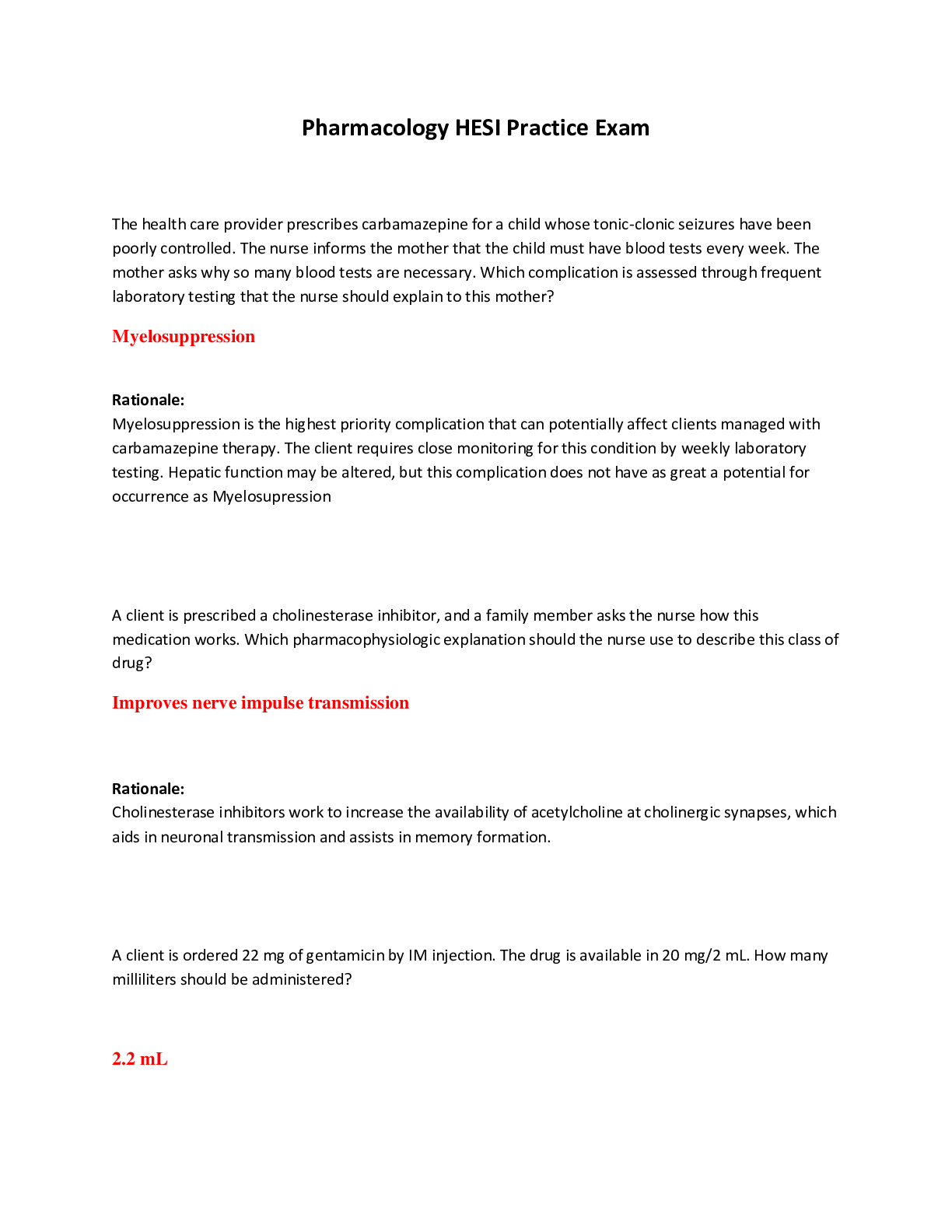
.png)
